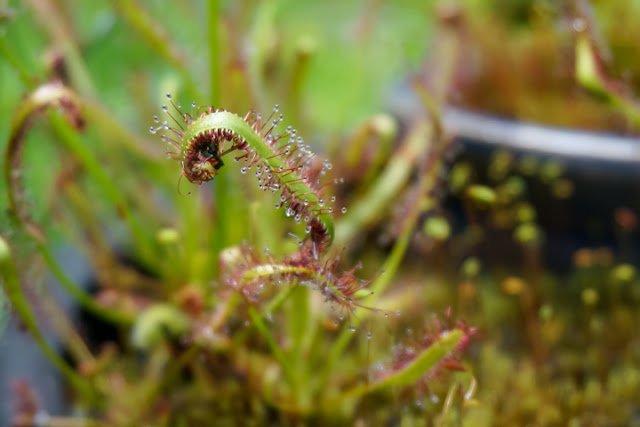Why Carnivorous Plants Eat Insects

The Drosera capensis (cape sundew, octopus plant) is a gorgeous plant that captures its prey in an absolutely sinister way. When an insect flies onto a leaf of the plant, it gets caught in the sticky tentacles. The sticky stuff is called mucin. As the insect attempts to escape, the leaf slowly curls up around it grabbing it with more tentacles. The plant then starts to digest the insect through the tentacles. Told you it was sinister!
You can check out a time-lapse video of the Drosera capensis grabbing its prey below:
Source: Photographer: Douglass Smith - "Drosera Capensis: time lapse eating a fly"
Contrary to what many people believe, carnivorous plants do not "eat" insects for energy (they get plenty of it from the sun). They eat insects for their nitrogen. In fact sundews, like the Drosera capensis, depend on insect sources of nitrogen so much so that most of them completely lack the enzyme (nitrate reductase) necessary to use soil sources of nitrogen. Basically the insects serve as plant fertilizer. Most carnivorous plants live in boggy areas, which typically have low levels of nitrogen. Evolutionarily, you can see why there would be selection pressure for the plants to gradually evolve ways to acquire nitrogen from other sources.
In 1983, Gowda et al. published a paper where they figured out the chemical makeup of the sticky digestive fluid produced by the Drosera capensis. You can find that paper here: http://www.sciencedirect.com/science/article/pii/0008621583882238
If you interested in exploring the evolution of carnivorous plants more you should check out a recent paper called "New evidence on the origin of carnivorous plants" published in PNAS by Thomas J. Givnish. You can find that here: http://www.pnas.org/content/112/1/10.short
Interesting information, tnx. The cat in the video was funny. I haven't seen those plants here in Hawaii, only venus and pitcher plants.